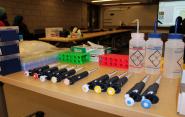Programming Life (in a Single Evening)

Ellen Jorgensen began her biohacking workshop with a promise so provocative that fifteen Yale students from such diverse fields as German literature, biomedical engineering, forestry, and global affairs spent the next five hours painstakingly fixated on micropipettes and test tubes: “By the end of the night, we’re going to build a genetic circuit and load it into an organism.”

Jorgensen’s workshop fulfilled that promise. Working in pairs, the students first selected which genetic parts they wanted to combine, then sequentially combined those parts into a loop of DNA called a plasmid. A weakened (read: safe) strain of E. coli was then loaded with the DNA and cultured in an incubator overnight. And voilá: E. coli cells that express by-design fluorescent colors.
The workshop, hosted on Nov. 20 by the Center for Engineering Innovation and Design (CEID), is the latest success in Jorgensen’s campaign to democratize access to the fields of molecular and synthetic biology. “Seemingly everyone can take a kit and do electrical hacking,” she points out. But as her workshop showed, biohacking has become nearly as accessible—people just don’t know it yet.
Jorgensen, the co-founder and executive director of the NYC-based community biolab Genspace, credits engineers’ “plug-and-play attitude to recombination” for such advances in accessibility. As she puts it, the long strings of nucleotides that make up DNA—labeled by scientists as A, T, C, and G—are not unlike the ones and zeros of computer code. Like software developers, biomolecular engineers have steadily parsed these long, complex chains of genetic code into “shorthand” genetic parts that can be quickly recombined, iterated, and tested. As just one example, Jorgensen’s workshop used a synthetic biology kit designed by Genomikon, a company that specializes in rapid genetic assembly techniques and educational outreach.
But even with the increased accessibility, the prospective biohacker still needs a resource, someone to point the newcomer in the right direction. This, says Jorgensen, is no different than any other field. “I hear all the time, ‘Well, anyone can use an Arduino.’ No. You need someone to teach you how to program an Arduino.” What makes electrical engineering seem so much easier than synthetic biology, she adds, is that people willing to teach electronics are everywhere. “So many people are sharing info about electronics,” while the notion of biohacking still seems inaccessibly closed off. No one is there to illuminate path.

Jorgensen’s lecture was the CEID’s latest event to offer such illumination, with workshops previously exploring the physics of bubbles, the mechanics of a four-stroke engine, and—of course—Arduino programming. “The field of synthetic biology is definitely more accessible now than it used to be,” Jorgensen says. “Which is possibly scary, but I hope you’re on the side that thinks it’s cool. I am.”

